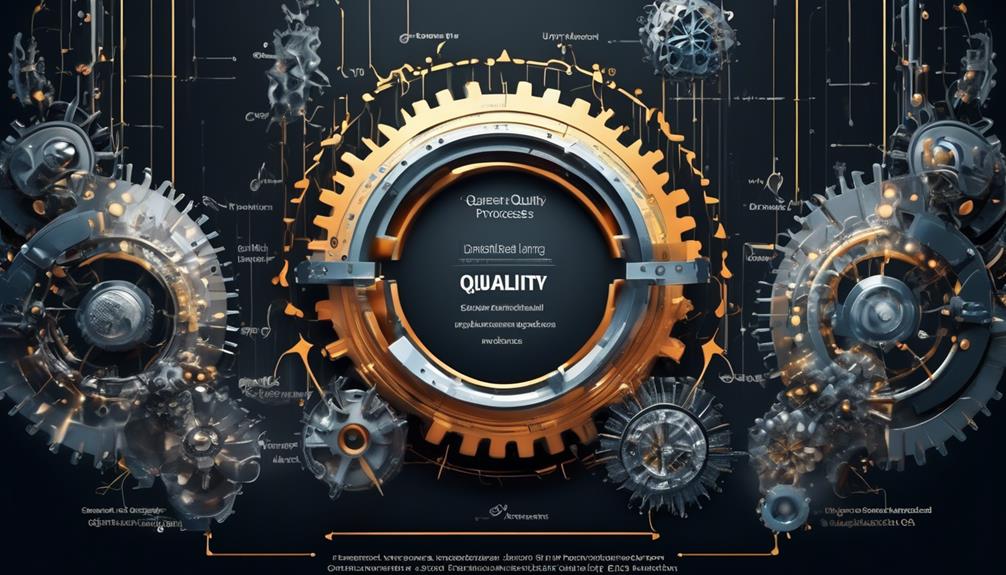Have you ever taken a moment to consider the significance of quality assurance in software development? It’s widely recognized that software bugs are causing the global economy an astonishing $1.1 trillion annually.
It's not just about catching mistakes – it's about ensuring the success and reliability of the final product.
In this discussion, we'll explore the multifaceted importance of quality assurance in software development and how it impacts not only the end-users but also the overall success of a company.
Key Takeaways
- Quality assurance in software development focuses on identifying and rectifying design or development defects to ensure the final product meets required quality standards.
- QA engineers play a pivotal role in software development by ensuring the end product meets customer expectations and industry standards through activities like testing for security, performance, and defect elimination.
- QA in software development is important as it ensures the delivery of high-quality software products, increases customer satisfaction, helps in finding and resolving defects early to save time and money, and ensures the final product meets high-quality standards.
- Neglecting quality assurance poses risks to technical integrity and commercial success, can lead to inefficient and defective software, damages company reputation and results in dissatisfied customers, increases likelihood of undetected bugs and errors, and causes disruptions and security vulnerabilities for end-users.
The Basics of Quality Assurance
In ensuring the high quality of software products, the basics of quality assurance focus on identifying and rectifying design or development defects to meet customer expectations. Quality assurance plays an important role in the software development lifecycle by ensuring that the final product meets the required quality standards.
It involves implementing processes and standards to guarantee a high-quality product for end-users. Our company acknowledges the significance of the QA process in delivering a quality product. The QA process involves thorough testing, analysis, and evaluation to assure excellent product delivery. By focusing on the basics of quality assurance, we aim to guarantee that the software meets customer expectations and functions as intended.
This involves meticulous attention to detail, analytical thinking, and clear communication throughout the product development phase. Quality assurance services are integral in assuring the reliability and functionality of the final product, making it an indispensable aspect of our software development process.
Role of QA in Development

With a meticulous focus on detail and a commitment to analytical thinking, quality assurance (QA) engineers play a pivotal role in the development of software products. QA is an integral part of the entire development process, ensuring that the end product meets customer expectations and complies with industry standards. The role of QA in software development encompasses a wide range of activities, including testing for security, performance, and the elimination of defects.
By incorporating QA into the product development lifecycle, organizations can save time and money by detecting errors early, which ultimately increases customer satisfaction with the software.
QA engineers are responsible for implementing and maintaining the QA process, working closely with developers and other stakeholders to identify potential issues and ensure the overall quality of the software. Their role extends beyond testing and encompasses a proactive approach to preventing issues from arising in the first place.
Importance of QA in Software
Playing a pivotal role in the development process, quality assurance (QA) ensures the delivery of high-quality software products that meet customer expectations and comply with industry standards. The importance of QA in software development can't be overstated. It's a key role in the QA process and product development, ensuring that the final product meets high-quality standards.
The following are the reasons why QA is important in software development:
- QA ensures the delivery of a high-quality product for end-users, leading to increased customer satisfaction.
- QA helps in finding and resolving design or development defects early in the process, saving time and money.
Risks of Neglecting Quality Assurance

Neglecting quality assurance in software development poses significant risks to both the technical integrity and the commercial success of a product.
Without proper QA processes in place throughout the development life cycle, the quality standards of the software product may not be met. This can lead to inefficient and defective software, ultimately damaging the company's reputation and resulting in dissatisfied customers.
In addition, the absence of thorough testing phases can increase the likelihood of undetected bugs and errors, potentially causing significant disruptions and security vulnerabilities for end-users.
Furthermore, neglecting QA can lead to increased costs and production times as a result of having to address and rectify issues that could have been prevented with effective quality assurance practices.
In today's competitive market, where high-quality software is imperative for success, overlooking the role of quality assurance in software development can have serious consequences for both the technical functionality and the commercial viability of a product.
Software Quality Assurance Standards
Software Quality Assurance Standards ensure that software products comply with predefined quality benchmarks, assessing both internal and external characteristics such as reliability, efficiency, and maintainability. These standards play a crucial role in product development by focusing on quality attributes and ensuring that the end product meets the required standards.
The QA process involves continuous improvement and process enhancement to uphold these standards, making it an integral part of quality control in software development.
Key Aspects of Software Quality Assurance Standards:
- Identification and Management of Defects: Standards help in identifying and managing defects, categorizing them based on severity, and taking necessary actions to rectify them.
- High-Quality End Products: Adherence to these standards ensures the delivery of high-quality software products, beneficial for consumers and businesses alike.
Software testers play a vital role in upholding these standards by rigorously assessing the software against predefined benchmarks, thereby contributing to the assurance of quality in software. The process improvement and continuous enhancement facilitated by these standards ultimately lead to the development of reliable and efficient software products.
Frequently Asked Questions
Why Quality Assurance Is Important?
Quality assurance is crucial because it ensures that our software meets high standards. It safeguards against errors, saving time and money in the long run.
Neglecting QA can lead to dissatisfied customers and damage our reputation. By prioritizing QA, we deliver secure, reliable, and high-performance software.
Ultimately, it contributes to customer satisfaction and protects our market reputation.
What Is the Role of QA in Development?
In software development, QA plays a crucial role in ensuring the quality and reliability of the end product. Our team meticulously examines every aspect of the software to identify and address any potential issues early on.
By doing so, we not only save time and resources but also contribute to the overall security and performance of the final product.
Our approach is driven by a commitment to delivering excellence at every stage of development.
Why You Think Quality Assurance Is a Vital Part of the Software Development Life Cycle?
We believe quality assurance is a vital part of the software development life cycle because it ensures the software meets customer expectations, impacts company culture by prioritizing quality, and saves time and money by detecting errors early.
It also guarantees user satisfaction, protects company reputation, and helps ensure security, ISO compliance, and company credibility.
Neglecting QA can lead to frustrated customers, making it crucial to implement QA early and aim for perfection in the final product.
What Is the Main Goal of Software Quality Assurance?
Our main goal in software quality assurance is to ensure the delivery of high-quality products to end-users. We focus on finding and addressing any design or development defects in the software.
This plays a crucial role in maintaining and improving our company's reputation in the market. By implementing a continuous improvement process, we aim to meet customer expectations and enhance overall product delivery.
Conclusion
In conclusion, quality assurance is crucial in software development. 88% of software defects can be prevented through effective QA processes. By identifying and addressing issues early on, QA ensures that the software meets customer expectations, saves time and money, and builds trust with users.
Neglecting QA can lead to security breaches, performance issues, and a damaged reputation. Therefore, investing in quality assurance is essential for delivering a superior product.









